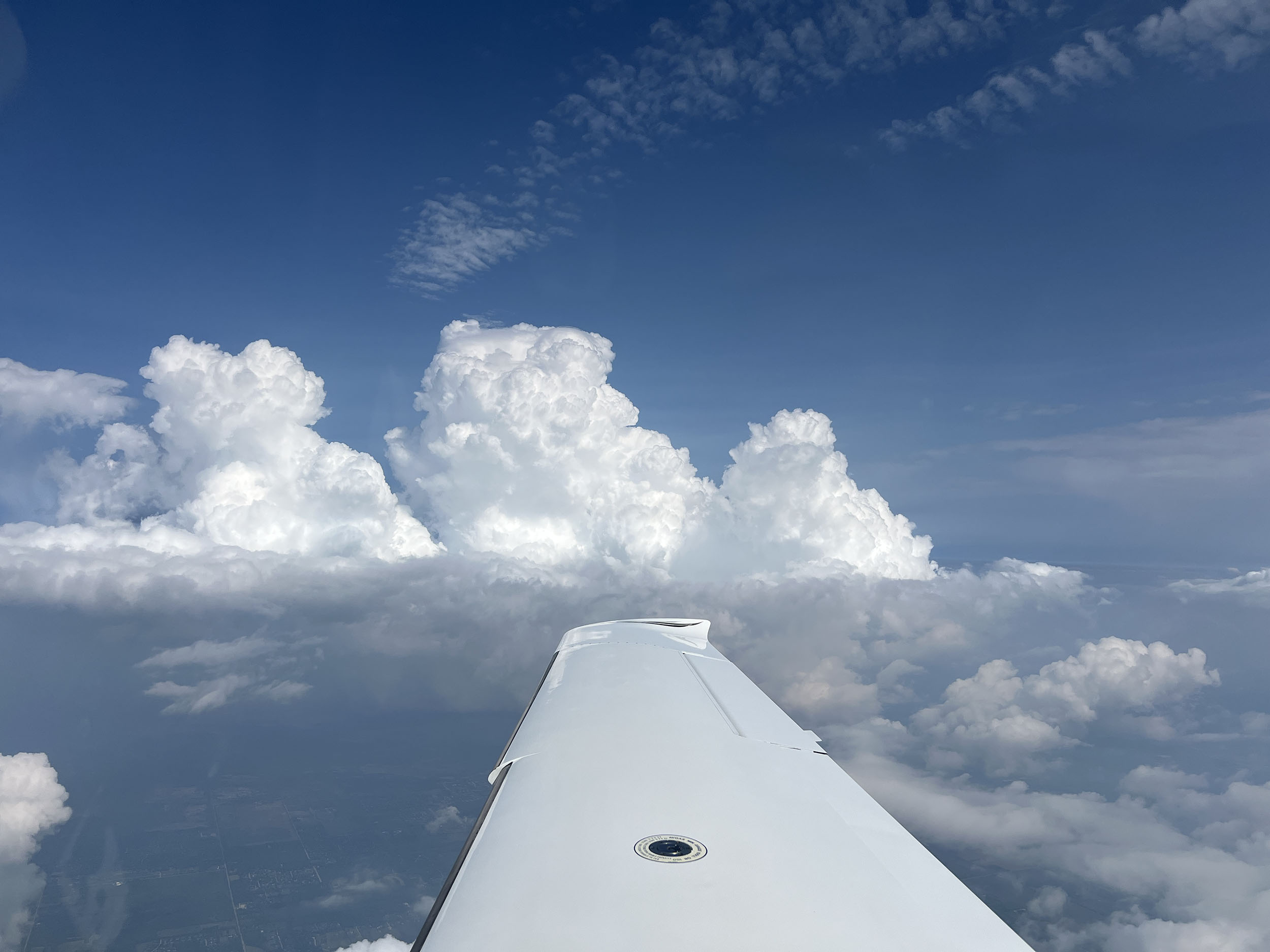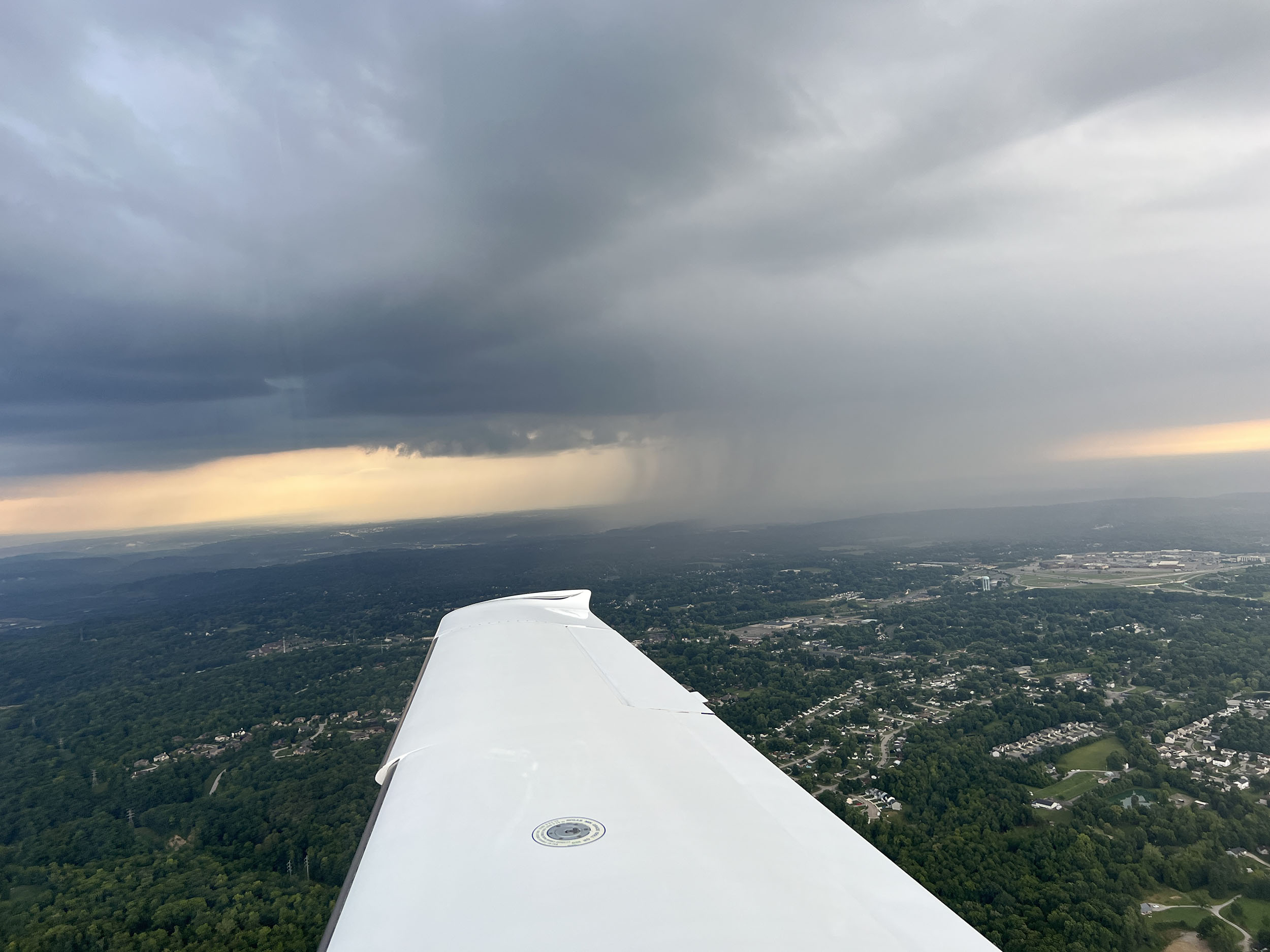|
Getting your Trinity Audio player ready...
|
I had the privilege of working with Richard Collins for a decade, and in that time I learned an awful lot about weather flying. It’s not surprising—the man probably knew more about real world weather than anyone. One of his most important lessons was also one of his simplest. He would often say, when presented with some weather scenario, “what you see is what you get.” His point was, no matter what the Flight Service briefer said and no matter what the TAF showed, the view from the left seat was all that mattered. CAVU forecast before takeoff and now thick clouds are all around your Cessna? What you see is what you get, so don’t waste any time complaining.
I’ve modified this a bit over the last decade as datalink weather has become standard equipment in basically every airplane I fly (whether it’s in the panel or on my iPad). With SiriusXM or ADS-B, we have more weather information than ever before, but regardless of what the iPad shows, the eyes always win.
That means reading clouds. Whether I’m flying IFR or VFR, most weather decisions come down to looking at clouds and trying to figure out what they are trying to say. Is that weather convective or just harmless showers? Will the ride be bumpy or smooth? Can I top that cell? Is there ice in that cloud layer? The answer almost always depends on what the clouds look like.
Five key questions
To be specific, I consider five different elements when looking at clouds.
1. Shape. Most pilots start here, and for good reason. It’s not a perfect guide, but smooth-looking clouds are typically smooth inside, bumpy-looking clouds are typically bumpy inside, and wavy clouds typically signify waves (especially over mountains). There are subtle details that matter here, like whether a cumulus cloud has a sharply defined edge, which usually signifies convection, or whether a cumulus cloud has a flat or slightly concave base, which suggests thermals. Think of the clouds as painting the movement of air with a white paintbrush and you’ll be able to visualize the atmosphere more easily.

It’s just a puffy white cloud, but the bright white color, sharply defined edges, and vertical development are signs of convection.
2. Color. Summer build-ups are usually bright white, while stratus clouds often have a gray shade. Worst of all are cumulonimbus clouds (thunderstorms), which have an almost black color that screams “go away.” These are all clues, just don’t believe the simple rule of thumb that gray means bad—often gray simply means the cloud deck is thick and is blocking more sunlight, and in fact the bumpiest air is typically inside or just above a bright white cloud. It’s bright white because it’s “fresh,” with new vertical development.

That cloud is dark gray because rain is about to fall out the bottom—as it already has to the right.
3. Tops. This is a tie-breaker for me. If a line of puffy white cotton balls is straight ahead, it makes a big difference if the tops of those clouds are at 5000 feet or 35,000 feet. It’s pretty hard for a cloud deck with tops below 10,000 feet to be severe weather. There might be ice or rain, but it’s likely not convective (at least not yet).
4. Growth rate. Knowing the tops can help, but remember they are not static. A fast-building thunderstorm can grow at many thousands of feet per minute. In fact, sometimes you can watch it happen, as a storm seems to explode upward. Noticing this development means you can often see a storm before it ever shows up on radar—and stay away.
5. Isolated or in lines. The presence of thunderstorms does not have to mean an automatic no-go: a few isolated cells can easily be circumnavigated visually. A solid line of towering cumulus clouds, on the other hand, can signal a squall line or fast-moving front that no airplane wants to tangle with. The same goes for ice: deviating around isolated cells isn’t just for storms.

There are probably some developing storms over there, but the cells are widely spaced with room to navigate.
There are plenty of other things to look at—glider pilots have all kinds of extra tricks for deciphering cloud types—but putting these five observations together can tell you an awful lot about the weather system you are flying in. One of the key questions you should be asking yourself is whether the air mass is stable or unstable. A stable air mass, signified by a flat-topped cloud deck with little vertical development and little to no vertical growth, probably means a smooth ride but with the potential for IFR conditions. An unstable air mass with rapidly growing cumulus clouds might offer good visibility, but probably with some storms around and some turbulence.
Complete the picture
The view from the left seat is essential, but it’s actually the last step in making smart weather decisions. The first step is a preflight briefing, and that should include a look at the big picture: the location of highs and lows, the movement of fronts, and the upper air patterns. Knowing this background information will help you fit your real-time cloud observations into a pattern, or theory of the larger weather system. A pilot trying to read clouds without knowing the big picture is like a doctor prescribing medication based on symptoms without knowing the underlying condition.
After starting with the big picture, you can progressively move smaller. That is, start with the weather depiction and upper air analysis, then go to the radar image and graphical forecast maps, and only then focus on location-specific reports like METARs. Once airborne, the same big-to-small approach still works: look at the big picture view based on the datalink radar, then move to pilot reports, and finally to the view out the front window. Nothing is more tactical than the specific cloud you’re about to fly through/above/below.
Note that ADS-B or SiriusXM weather still has a critical role to play here. The detailed weather map on your iPad can help you refine your theory of the weather system, comparing current conditions to the forecast and watching the trend with animated radar. Most importantly, datalink weather is invaluable for evaluating plan B and C—and remember the golden rule of weather flying is to always have an out.
Cloud reading in action
I used exactly this approach on a recent flight from Youngstown, Ohio back to Sporty’s in Batavia, Ohio. I was on an IFR flight plan and flying a Cirrus SR22 with a TKS deice system, but it’s not a full FIKI system and temperatures were below zero at altitude, so I wanted to avoid as many clouds as possible. That made this a classic “file IFR but stay VMC” trip.
A cold front had moved through the day before and the radar showed mostly green, so I was on the back side of the worst weather, but there were a few cells on the radar that looked convective. Sure enough, after climbing on top of the first cloud layer (about 5,000 feet) those towering cells announced their presence with billowing cumulus clouds and tops well into the flight levels. Forget the radar—I would be avoiding all of those clouds visually.
Fortunately there were wide gaps between those cells, and the rest of the cloud tops were below 10,000 feet, flat, and not growing. All good signs. I climbed to stay on top of this stratus layer in order to avoid any ice and deviated around the build-ups.
When it was time to descend, I avoided any clouds that appeared more cumulus in shape or had vertical development. The result was a mostly smooth ride through stratus clouds and a visual approach to landing. In short, I was picky about which clouds I stuck my nose in.
This is an example of how “taking a look” can work with datalink weather on board. I was making most of my weather decisions based on the view from the cockpit, but ForeFlight made it easy to keep track of my escape routes, and to know what was around the next line of clouds. I could compare radar with METARs and PIREPs to get a three dimensional understanding of the weather system, which is especially helpful when the clouds are layered like they were on this day.
Two other things helped. First, I had lots of fuel, so even a lengthy deviation was a legitimate option (my plan C was to go all the way around the weather, a 90-mile detour). Second, a flexible schedule meant I could land and wait for the weather to move through if needed (my plan D). Both of these support the golden rule of weather flying.
Knowing how to read clouds, and how to correlate the cockpit view with the datalink weather view, can certainly make your flying safer. But it can do more than that. Being able to read clouds can also help you fly more, completing trips that you might not otherwise make and giving you the confidence to climb through a layer of clouds to find that beautiful sun on top.
- Go-arounds don’t have to be hard - December 8, 2025
- Guard frequency in the age of social media - October 13, 2025
- Why are spatial disorientation accidents on the rise? - September 8, 2025










Great article John!
Love this practical approach to deciphering weather. Do you recommend any particular sources for more “practical weather” education? There’s no shortage of books and videos on the technical side, but I would love to learn more about real world weather decision making. Thanks for the great content!
Dr. Scott Dennstaedt (Meteorologist/Pro Pilot) has excellent materials on his site here:
https://www.avwxtraining.com/
I am not affiliated with the site but have read his books, which are excellent.
I’m biased, but here are some of my favorite resources:
– Flying the Weather Map, by Richard Collins. This is an old book now, but excellent if you’re looking for practical weather tips. https://a.co/d/42WMsVG
– Weather Flying, by Bob and Rob Buck. This is the classic weather book and it’s still a must read. https://www.barnesandnoble.com/w/weather-flying-fifth-edition-robert-n-buck/1125545010
– Aviation Weather course from Sporty’s. I helped develop this, and it puts some of these concepts into video. https://www.sportys.com/aviation-weather-a-pilot-s-guide-online-app-tv.html
I am a retired power pilot of 60 years with about 5,000 hours, virtually all in Mooneys. I gave up the powered aircraft for gliders, a great change.
Any suggestions for weather reading applicable to gliders? I use to avoid turbulence, now it means possible lift. The times they are a changing!
Bobby
John, I just happened to read a few reviews of Richard’s classic, and came across this one:
“That was one boring book! Didn’t learn much, and the part where he describes the weather he encounters is useless. He only describes what he sees and not why the weather is like that.”
Man, if I had nickel…
Good practical insights.
A few of mine:
-ADS-B/Satellite wx also good for looking at a wide area of terminal weather depictions (red/green dots) on a chart page, if your destination is the only green dot for miles around it may be good, but not for long. An area with many green dots may be a better option.
-for VFR, 1000′ broken with 10 mi viz is much better than 600′ few, 800 scattered, 1400′ broken and 3 mi viz…and don’t even think that’s at all doable at nx!
-unless you have onboard radar, know how to use it, and have at least one “out” always stay VMC around t-storms!
-ADS-B/Satellite wx good for planning on what’s behind what you can see, a “good” path you can see might actually be a dead end
…and when it comes to weather you better ALWAYS have schedule flexibility!
…and a passenger favorite, the temperature drop above fair wx puffies is very welcome on hot days. Those puffies’ altitude is an indicator of that drop.
When I first start flying turbines, the advice I got was to not fly through clouds above 15,000 feet. The point being, high clouds have energy. Now that I’m flying my own jet and every flight is IFR, I constantly hear airliners asking for deviations left and right for weather (and I do the same). Even airliners don’t fly through buildups, but as passengers in the back we just aren’t aware that they are avoiding them. (A solid cloud deck without vertical buildups is a different story, and usually not a problem).
I was a disciple of Richard Collins weather articles long ago. You can do all of what John describes in this excellent article, but as Richard used to say you always can go take a look. However, you may not get to your destination.
Thanks John.
Excellent article! As a newly minted instrument pilot, I don’t think there is enough practical education on what is safe to fly through and what isn’t. Living in a part of the country with significant convective activity during the summer, I often find myself looking at the clouds and asking “can I fly through that?” Sometimes it’s difficult to determine. From my observation, there is a fine line between fair weather cumulus and the start of something more ominous.
Flying at night in the tropics adds another dimension, lightning is your friend, acting as natures lighthouse. Threading your way around these tight little cells the flashes say very loudly KEEP AWAY there’s trouble ahead. The out is to land and wait about an hour and they are most likely gone.
It was not until I moved up to a Citation that I realized the airlines and business jets do all they can to just stay out of the clouds. Nothing good happens in them. Of course jets have the luxury of flying above much of the time. Asking for deviations and better rides seems like 80% of the radio talk with ATC in the flight levels. Sure you have to go through stuff sometimes, but you get better at learning what to stay away from and develop the confidence to negotiate. Flat is good, verticial development is bad. Reading the edges, color, tops and movement are all key. When I was a less experienced piston pilot learning IMC flying, I felt really unsure about my ability to judge things, but I have learned the big boys are more cautious than anyone. Staying visual around buildups is absolutely essential.
I agree 100%. After a few hundred hours in the Pilatus, I realized that cruise flight was basically all about dodging ugly clouds.
Great article, and one I have bookmarked. BTW – how did you find Scott’s last weather book? To technical or practical? I have debated about buying it.
It’s both. Honestly, as an instrument pilot flying cross country, I don’t think you can ever know too much about weather so I would read it.